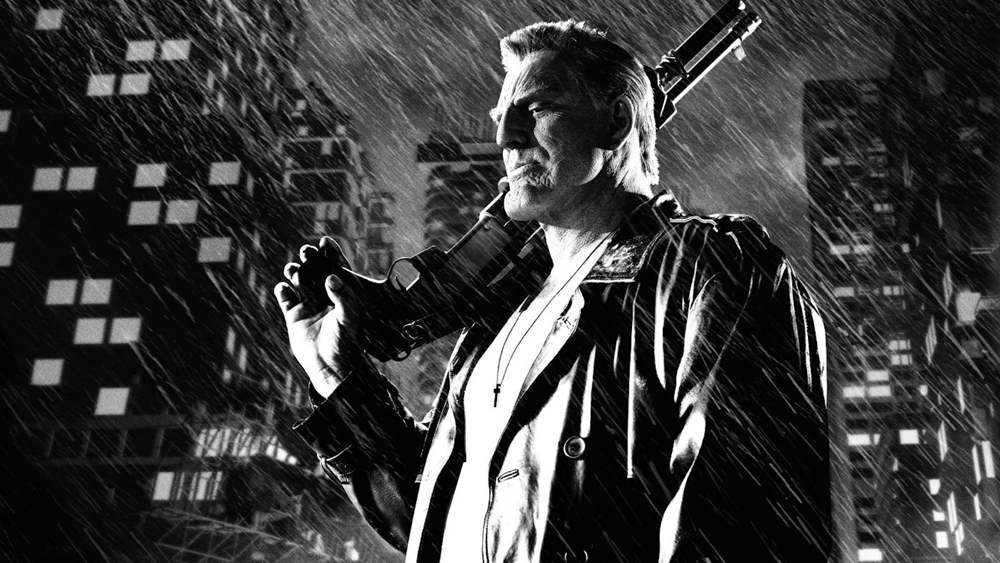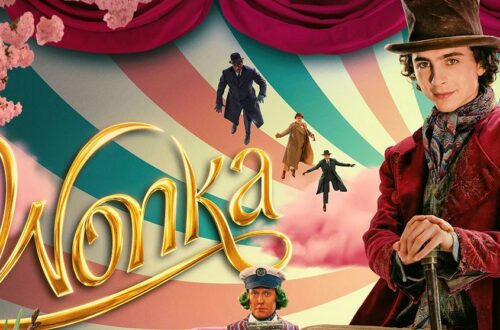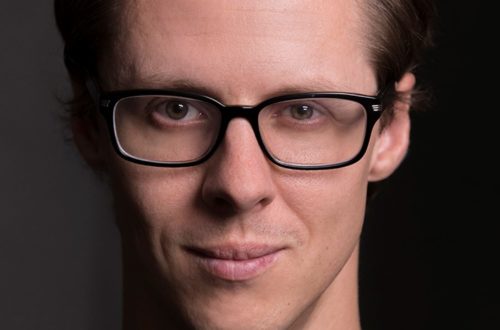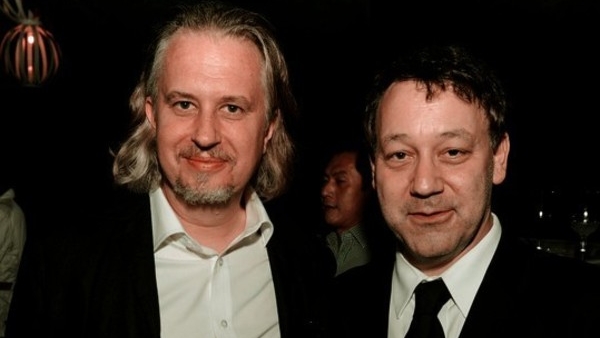 The last time we spoke with film and TV composer Carl Thiel he had just finished up scoring the music to Machete Kills. The music was as much fun as the insane action on screen. Now here we are, less than a year later and Thiel has not only contributed music to another Robert Rodriguez film but also the themes for the TV series based on Rodriguez’ From Dusk Till Dawn. No stranger to tight time frames and working hard, Carl Thiel continues to add that gritty and hard-edged sound to each and every world Rodriguez puts on screen.
The last time we spoke with film and TV composer Carl Thiel he had just finished up scoring the music to Machete Kills. The music was as much fun as the insane action on screen. Now here we are, less than a year later and Thiel has not only contributed music to another Robert Rodriguez film but also the themes for the TV series based on Rodriguez’ From Dusk Till Dawn. No stranger to tight time frames and working hard, Carl Thiel continues to add that gritty and hard-edged sound to each and every world Rodriguez puts on screen.
It’s always a blast catching up with him, so enjoy our session with composer Carl Thiel as we discuss the new music in Sin City: A Dame To Kill For.
GST: Thanks for taking some time to talk with us again Carl. How’ve you been and how was the premiere? You went to two this week right?
CT: The premiere was great. We had the one in L.A. on Tuesday and then yesterday we were in Austin. So I’ve been traveling a lot and sleeping very little *laughs* but that’s the way it goes. It was really well received, the audience was great in both places. It’s really interesting to see how different markets react to it. The L.A .crowd has its own vibe and of course the Austin crowd has its own vibe.
GST: I hadn’t read the graphic novels and I had a little trouble figuring this out so maybe you can help me. This is a prequel and a sequel right?
CT: Yeah, I know what you mean. It is a little confusing. I had a bit of a hard time myself and I worked on the film. *laughs* I haven’t read all the graphic novels either but what I understand, after talking with Robert, is that Frank Miller wrote the stories out of order. So if you read the graphic novels they are also out of sequence. In the first story Marv dies but you see him come back in all the other stories. Also, what you see in this movie is not in the original graphic novel. The ending is a new ending that Frank Miller wrote just for the movie so fans of the novel can have something to new to look forward to when they see this.
GST: Since there were existing themes in place, how do you start the process of adding to what Robert Rodriguez, John Debney and Graeme Revell did for the first film?
CT: Well I’m a huge fan of the first movie and the score. I have so much respect for John Debney and Graeme Revell for the fantastic score they did, Robert too, and if you’re familiar with that score you’ll notice there were three very distinct themes for each of the overlapping stories. Basically Robert took one story, Graeme took another and John took the third. Each has its own vibe and soundscape. So we wanted to approach this Sin City with the same idea and we had an amazing template to start with
especially because so many of the characters came back for this one.
We wanted to keep that same vibe but add more to the musical atmosphere. So taking the existing motifs and expanding it to include these new characters like Ava, Joey and Johnny we created melodic content for them.
I don’t know if you were able to pay a lot of attention to the new musical themes, because there’s a lot happening on the screen, but there’s also a lot going on with a theme like Ava’s. Robert wrote a very nice melodic composition for her. It was very slick and had a lot of bendy strings that followed her character. It was inspiring to work off because the melody he wrote for her is very unpredictable, a lot like her character actually. You don’t know where she’s going to go. She’s kind of sexy, or sometimes she’s innocent, then at certain points she’s really evil and that’s what we wanted to do with the melody.
GST: Well I respect you and Robert both as artists but, honestly, when Eva Green is on the screen, music is the last thing anyone is going to be thinking of. *laughs*
CT: *laughs* I totally agree! *laughs*
GST: A few of the themes you wrote were ones like “Marv vs Frat Boys” and “Joey” and both you and Robert are picking up on what was done in the first film. So what discussions did you have to decide who took what theme?
CT: I had just finished From Dusk Till Dawn the TV show and Robert called me one day back in May and told me he wanted me to start work on Sin City 2. Of course we had an insane deadline, like we always do, and the first time I saw the film was when I was in his studio. He was very adamant about keeping the same feel as the first movie. But like you said, we talked and looked at which characters we wanted to take. I forget the actual discussion but since there were some scenes where our characters shared screen time we had to decide how to blend themes together. So when Robert finished he sent me a demo of the Ava theme and I worked on weaving the Dwight theme into those scenes.
GST: When you scored Machete Kills you had a theme for nearly every character. Sin City is similar but in addition to a multitude of characters you also have to cover a variety of emotions. It can be funny, whether intentionally or not, and then you have these very melodramatic moments like a soap opera and a lot of over-the-top situations. So how do you weave the themes in and around the events of the film so it doesn’t feel forced?
CT: That’s a good question, because working with Robert, on a lot of the work we do, the music takes a backseat to the story. But when I started working on this Sin City he told me, “you know, for this movie we really need to go over the top.” It’s a completely different movie than the ones that Robert usually makes. The lack of information on screen, the lack of color, a lot of voice over, etc. Plus the movie is like a noir so this is the one movie where we can get away with going over the top. The music is just as important as the narration and the visuals so it gave us the freedom to do whatever we wanted. And we really took more chances than we would have done on a regular score.
GST: The series, I guess we can call it that now, has a very distinctive sound. So aside from the saxophone, which is very apparent, what do you consider the signature instruments that really help define this score?
CT: Each character has a signature sound. Ava had the bendy strings, the real oozy, high melody strings that gives it a real classical feel. Marv was driven by the saxophone which was so guttural, so street, and so primal.
Dwight was more trumpets and those two go back to what John and Graeme did on the first movie. On the Johnny character we went with a clarinet because Robert didn’t really want to give him a very powerful sound. The clarinet gave him a nice melodic lead but it didn’t always work so we supplemented it with saxophone in certain places.
GST: The themes are layered. There’s a main instrument like you mentioned, but there are also supplemental sounds like screeching metal sounds or synthesizer effects. So what steps do you take to layer the track with things that don’t sound like instruments?
CT: That’s more of a gut feel you get watching the music on screen. The music gives you the melodic effect but when you need something else at a particular moment, to elicit an emotional response from the
audience, it can be an atonal sound and that’s where the metallic sounds and sound design come into play.
Robert and I have a very large library of digital sounds. We have almost identical set ups actually, but if I don’t find anything in the library that works I’ll perform something myself and alter it to make it weird or whatever I need. We catalog everything and if Robert wants hear something later I’ll send him the session file and he can add what he wants to it and send it back to me. Or vice versa, he can send me something and I’ll add layers to that.
GST: You said there wasn’t a lot of time to write the score, so how long did you have and what made it difficult?
CT: We had six weeks to work on this and there’s pretty much wall to wall music in the film so that was a challenge right there. But I’ve noticed working with Robert for so long that having a short period of time and a deadline really brings out the best in us. Looking back on it I laugh because when you’re in the middle of it you constantly ask yourself “how the hell am I going to get this done in this amount of time?”.
But it forces you to put your best efforts forward. Now that we’re done I can be proud that we really came up with a lot of great music and nailed it in six weeks. When I don’t have a deadline I’ll procrastinate like crazy. *laughs* But when I know something has to be delivered we just go for it – 16 hour days, no Sundays off and the last couple days we didn’t sleep and that’s just how we got it done.
GST: Seems to be the case with every composer I talk to. Doesn’t sound like any project is an optimal condition but then again, a deadline is a deadline right?
CT: Exactly and that’s happening more and more these days because technology is changing everything about what we do. It’s kind of a blessing and a curse because now the director or creative team has the ability to change things up to the last minute. You don’t have to print anything or do the mechanical editing and lock the film. The film is basically never locked these days, and even through the mix they’re still making changes to the picture so we have to be ready to make changes as well even to the last minute.
GST: If you find that you’ve written too much music how do you scale something back without leaving large gaps of silence in the projects?
CT: Well the way we work is that we always deliver stems. Not sure if you’re familiar with that concept but every time I work with Robert, or any other director,
every cue that I write I will assemble in layers. There will be horns on a layer, the strings on a layer, the percussion on a layer, then the lead instrument will have its own layer. That way they are all separate and that gives us, or the director control of everything at the final mix.
So if Robert looks at a scene and thinks the music is too busy in that moment he can dial it down because he has the option to take out stings so it’s not so heavy. Or he can take out the melody and just leave the chords or he can strip it down to just percussion if he needs to. That gives him flexibility if he wants to change something, again, even at the last minute.
That’s kind of the way it works these days. And even when you record a real orchestra they can record the sections separately too – stings in one session or the brass in a different session so they have the option to separate that for the same reason.
GST: Both of these films are wildly inventive on many different levels. Visuals, narrative and music like you said but also direction. After the success of the first one why did it take so long to get a follow up film?
CT: That’s more of a Robert question but from what I’ve got from my discussions with him it’s just about timing. There are so many elements at work it’s tough to get everything lined up just right. Funding is one part of it, but aside from that it’s the people involved. You have to coordinate everyone’s schedules, a lot of these characters are big actors, and that can be pretty tough some times.
GST: I always hate to ask this when a movie is just coming out, but is there talk of another one? Or, like the From Dusk Till Dawn TV show, could this find life and an audience on the small screen?
CT: I haven’t heard anything about a TV show but at the premiere Robert was asked about a third film. What he said, and I’m paraphrasing, is that when he showed Frank the first cut of Sin City 2 Frank said, I love it, let’s start working on Sin City 3. So the willingness is there but that’s all I know.
GST: So aside from scoring, how’s things going with Chingon?
CT: Oh it’s great. I didn’t get to play with them at the premieres but Bruce Willis sat in with them in L.A. and that was a lot of fun. He’s a great blues player and has his own band. Last night Chingon played after the Austin premiere. We actually used them in the From Dusk Till Dawn TV show. Because the show follows the movie From Dusk Till Dawn they are the band playing in the bar.
GST: Cool. I’ll check that out now that it’s on Netflix. Have a good one Carl. Hope to catch up with you after Sin City 3 or Machete Kills Again….In Space! *laughs*
CT: *laughs* You got it. *laughs* Fingers crossed. Talk to you soon Marc!
Thanks to Carl for his time. Sin City: A Dame to Kill For is in theaters now. Little heads up to all you film score fans, keep an eye out for an upcoming contest where we will be giving away copies of the CD soundtrack autographed by Carl himself!



